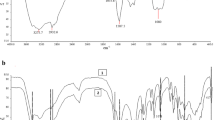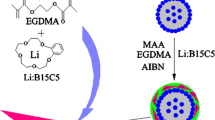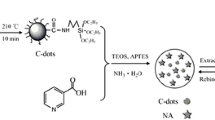Abstract
A molecularly imprinted polymer (MIP) was fabricated for selective recognition of the highly persistent pollutant perfluorooctane sulfonate (PFOS). The MIP was prepared from chitosan and doped with fluorescent carbon quantum dots (CQDs). It was characterized by fluorescence spectrophotometry, scanning electron microscopy, and Fourier transform infrared spectroscopy. The fluorescence of the CQDs, best measured at excitation/emission wavelengths of 350/460 nm, is enhanced by PFOS, and the effect is much stronger for the MIP than for the nonimprinted polymer (NIP). The imprinting factor is 2.75. The method has good specificity over sodium dodecyl sulfate (SDS), perfluorooctanoic acid (PFOA), sodium dodecyl sulfonate (SDS’), sodium dodecyl benzene sulfonate (SDBS), perfluorooctanesulfonyl fluoride (POSF), perfluorobutane sulfonate (PFBS) and 1-octanesulfonic acid sodium (OSA). Fluorescence increases linearly in the 20–200 pg·L−1 POSF concentration range in aqueous solution. The method was applied to the determination of PFOS in spiked serum and urine samples. The limits of detection are 66 and 85 pg·L−1 for serum and urine samples respectively. The recoveries ranged from to 81–98%, with relative standard deviations in the range of 1.8–8.2%. Compared with LC-MS/MS, this assay is more convenient since the material can be prepared flexibly and the method can be applied on-site.

Schematic of the fabrication of a molecularly imprinted chitosan hydrogel doped with CQDs for selective fluorometric determination of PFOS. a. The photo of chitosan hydrogel. b, c, d, e represents the hydrogel observed under UV lamp. b’, c’, d’, e’ represents the inner structure of hydrogel bead.





Similar content being viewed by others
References
Houde M, Czub G, Small JM, Backus S, Wang X, Alaee M, Muir DC (2008) Fractionation and bioaccumulation of perfluorooctane sulfonate (PFOS) isomers in a Lake Ontario food web. Environ Sci Technol 42:9397–9403. https://doi.org/10.1021/es800906r
Loos R, Wollgast J, Huber T, Hanke J (2007) Polar herbicides, pharmaceutical products, perfluorooctanesulfonate (PFOS), perfluorooctanoate (PFOA), and nonylphenol and its carboxylates and ethoxylates in surface and tap waters around Lake Maggiore in northern Italy. Anal Bioanal Chem 387:1469–1478. https://doi.org/10.1007/s00216-006-1036-7
Tittlemier SA, Pepper K, Seymour C, Moisey J, Bronson R, Cao XL, Dabeka RD (2007) Dietary exposure of Canadians to perfluorinated carboxylates and perfluorooctane sulfonate via consumption of meat, fish, fast foods, and food items prepared in their packaging. J Agric Food Chem 55:3203–3210. https://doi.org/10.1021/es800906r
Olsen GW, Mair DC, Reagen WK, Ellefson ME, Ehresman DJ, Butenhoff JL, Zobel LR (2007) Preliminary evidence of a decline in perfluorooctanesulfonate (PFOS) and perfluorooctanoate (PFOA) concentrations in American red Cross blood donors. Chemosphere 68:105–111. https://doi.org/10.1016/j.chemosphere.2006.12.031
Saito K, Uemura E, Atsushi I, Hiroyuki K (2010) Determination of perfluorooctanoic acid and perfluorooctane sulfonate by automated in-tube solid-phase microextraction coupled with liquid chromatography-mass spectrometry. Anal Chim Acta 658:141–146. https://doi.org/10.1016/j.aca.2009.11.004
Poothong S, Boontanona SK, Boontanonb N (2012) Determination of perfluorooctane sulfonate and perfluorooctanoic acid in food packaging using liquid chromatography coupled with tandem mass spectrometry. J Hazard Mater 205:139–143. https://doi.org/10.1016/j.jhazmat.2011.12.050
Feng H, Wang NY, ThanhThuy TT, Yuan LJ, Li JZ, Cai QY (2014) Surface molecular imprinting on dye-(NH2)-SiO2 NPs for specific recognition and direct fluorescent quantification of perfluorooctane sulfonate. Sensors Actuators B Chem 195:266–273. https://doi.org/10.1016/j.snb.2014.01.036
ThanhThuy TT, Li JZ, Feng H, Cai J, Yuan LJ, Wang NY, Cai QY (2014) Molecularly imprinted polymer modified TiO2 nanotube arrays for photoelectrochemical determination of perfluorooctane sulfonate (PFOS). Sensors Actuators B Chem 190:745–751. https://doi.org/10.1016/j.snb.2013.09.048
Yang S, Li Y, Wang S, Wang M, Chu M, Xia B (2018) Advances in the use of carbonaceous materials for the electrochemical determination of persistent organic pollutants. A review. Microchim Acta 185(112). https://doi.org/10.1007/s00604-017-2638-9
Chen SH, Li AM, Zhang LZ, Gong JM (2015) Molecularly imprinted ultrathin graphitic carbon nitride nanosheets based electrochemiluminescence sensing probe for sensitive detection of perfluorooctanoic acid. Anal Chim Acta 896:68–77. https://doi.org/10.1016/j.aca.2015.09.022
Hua XG, Pana JL, Hua YL, Li GK (2009) Preparation and evaluation of propranolol molecularly imprinted solid-phase microextraction fiber for trace analysis of β-blockers in urine and plasma samples. J Chromatogr A 1216:190–197. https://doi.org/10.1016/j.chroma.2008.11.064
Xu ZG, Hu YF, Hu YL, Li GK (2010) Investigation of ractopamine molecularly imprinted stir bar sorptive extraction and its application for trace analysis of β-agonists in complex samples. J Chromatogr A 1217:3612–3618. https://doi.org/10.1016/j.chroma.2010.03.046
Liu HL, Fang GZ, Wang S (2014) Molecularly imprinted optosensing material based on hydrophobic CdSe quantum dots via a reverse microemulsion for specific recognition of ractopamine. Biosens Bioelectron 55:127–132. https://doi.org/10.1016/j.bios.2013.11.064
Ren XH, Liu HC, Chen LG (2015) Fluorescent detection of chlorpyrifos using Mn (II)-doped ZnS quantum dots coated with a molecularly imprinted polymer. Microchim Acta 182:193–200. https://doi.org/10.1007/s00604-014-1317-3
Dan L, Wang HF (2013) Mn-doped ZnS quantum dot imbedded two-fragment imprinting silica for enhanced room temperature phosphorescence probing of domoic acid. Anal Chem 85:4844–4848. https://doi.org/10.1021/ac400250j
Ren XH, Chen LG (2015) Quantum dots coated with molecularly imprinted polymer as fluorescence probe for detection of cyphenothrin. Biosens Bioelectron 64:182–188. https://doi.org/10.1016/j.bios.2014.08.086
Liu JX, Chen H, Lin Z, Lin JM (2010) Preparation of surface imprinting polymer capped Mn-doped ZnS quantum dots and their application for chemiluminescence detection of 4-nitrophenol in tap water. Anal Chem 82:7380–7386. https://doi.org/10.1021/ac101510b
Chen YP, Wang DN, Yin YM, Wang LY, Wang XF, Xie MX (2012) Quantum dots capped with dummy molecularly imprinted film as luminescent sensor for the determination of tetrabromobisphenol a in water and soils. J Agric Food Chem 60:10472–10479. https://doi.org/10.1021/jf3026138
Wang HF, He Y, Ji TR, Yan XP (2009) Surface molecular imprinting on Mn-doped ZnS quantum dots for room-temperature phosphorescence optosensing of pentachlorophenol in water. Anal Chem 81:1615–1621. https://doi.org/10.1021/ac802375a
Li HB, Li YL, Cheng J (2010) Molecularly imprinted silica nanospheres embedded CdSe quantum dots for highly selective and sensitive optosensing of pyrethroids. Chem Mater 22:2451–2457. https://doi.org/10.1021/cm902856y
Xu SF, Lu HZ, Li JH, Song XL, Wang AX, Chen LX, Han SB (2013) Dummy molecularly imprinted polymers-capped CdTe quantum dots for the fluorescent sensing of 2,4,6-trinitrotoluene. ACS Appl Mater Interfaces 5:8146–8154. https://doi.org/10.1021/am4022076
Zhou Y, Qu ZB, Zeng YB, Zhou TS, Shi GY (2014) A novel composite of graphene quantum dots and molecularly imprinted polymer for fluorescent detection of paranitrophenol. Biosens Bioelectron 52:317–323. https://doi.org/10.1016/j.bios.2013.09.022
Liu HL, Fang GZ, Zhu HD, Li CM, Liu CC, Wang S (2013) A novel ionic liquid stabilized molecularly imprinted optosensing material based on quantum dots and graphene oxide for specific recognition of vitamin E. Biosens Bioelectron 47:127–132. https://doi.org/10.1016/j.bios.2013.03.006
Hao TF, Wei X, Nie YJ, Xu YQ, Yan YS, Zhou ZP (2016) An eco-friendly molecularly imprinted fluorescence composite material based on carbon dots for fluorescent detection of 4-nitrophenol. Microchim Acta 183:2197–2203. https://doi.org/10.1007/s00604-016-1851-2
Chen BB, Liu ZX, Deng WC, Zhan L, Liu ML, Huang CZ (2016) A large-scale synthesis of photoluminescent carbon quantum dots: a self-exothermic reaction driving the formation of the nanocrystalline core at room temperature. Green Chem 18:5127–5132 http://pubs.rsc.org/en/content/articlehtml/2016/gc/c6gc01820c
Wu ZL, Zhang P, Gao MX, Liu CF, Wang W, Leng F, Huang CZ (2013) One-pot hydrothermal synthesis of highly luminescent nitrogen-doped amphoteric carbon dots for bioimaging from Bombyx mori silk-natural proteins. J Mater Chem B 122:2868–2873. https://doi.org/10.1039/C6GC01820C
Zhou J, Yang Y, Zhang CY (2013) A low-temperature solid-phase method to synthesize highly fluorescent carbon nitride dots with tunable emission. Chem Commun 49:8605–8607. https://doi.org/10.1039/C3CC42266F
Zhao HX, Liu LQ, De Liu Z, Wang Y, Zhao XJ, Huang CZ (2011) Highly selective detection of phosphate in very complicated matrixes with an off-on fluorescent probe of europium-adjusted carbon dots. Chem Commun 47:2604–2606. https://doi.org/10.1039/C0CC04399K
Yang Q, Wei L, Zheng X, Xiao L (2015) Single particle dynamic imaging and Fe3+ sensing with bright carbon dots derived from bovine serum albumin proteins. Sci Rep 5(17727). https://doi.org/10.1038/srep17727
Ma Y, Zhang Z, Xu Y, Ma M, Chen B, Wei L, Xiao L (2016) A bright carbon-dot-based fluorescent probe for selective and sensitive detection of mercury ions. Talanta 161:476–481. https://doi.org/10.1016/j.talanta.2016.08.082
Yu Q, Deng SB, Yu G (2008) Selective removal of perfluorooctane sulfonate from aqueous solution using chitosan-based molecularly imprinted polymer adsorbents. Water Res 42:3089–3097. https://doi.org/10.1016/j.watres.2008.02.024
Hu L, Li Y, Zhang WL (2016) Characterization and application of surface-molecular-imprinted-polymer modified TiO2 nanotubes for removal of perfluorinated chemicals. Water Sci Technol 74:1417–1425. https://doi.org/10.2166/wst.2016.321
Qian Z, Ma J, Shan X, Feng H, Shao L, Chen J (2014) Highly luminescent N-doped carbon quantum dots as an effective multifunctional fluorescence sensing platform. Chem Eur J 20:2254–2263. https://doi.org/10.1002/chem.201304374
Chandra S, Pathan SH, Mitra S, Modha BH, Goswami A, Pramanik P (2012) Tuning of photoluminescence on different surface functionalized carbon quantum dots. RSC Adv 2:3602–3606 http://pubs.rsc.org/en/content/articlehtml/2012/ra/c2ra00030j
Zuo P, Lu X, Sun Z, Guo Y, He H (2016) A review on syntheses, properties, characterization and bioanalytical applications of fluorescent carbon dots. Microchim Acta 183:519–542. https://doi.org/10.1007/s00604-015-1705-3
Acknowledgments
This work was supported by the National Natural Science Foundation of China (21305013) and the Guangdong Provincial Key Platform and Major Scientific Research Projects for Colleges and Universities (No.2014KZDXM073, 2015KCXTD029). The authors also thanks Thonebio. Co. Ltd. for technical support.
Author information
Authors and Affiliations
Corresponding author
Ethics declarations
The author(s) declare that they have no competing interests.
Electronic supplementary material
ESM 1
(DOC 1134 kb)
Rights and permissions
About this article
Cite this article
Jiao, Z., Li, J., Mo, L. et al. A molecularly imprinted chitosan doped with carbon quantum dots for fluorometric determination of perfluorooctane sulfonate. Microchim Acta 185, 473 (2018). https://doi.org/10.1007/s00604-018-2996-y
Received:
Accepted:
Published:
DOI: https://doi.org/10.1007/s00604-018-2996-y




